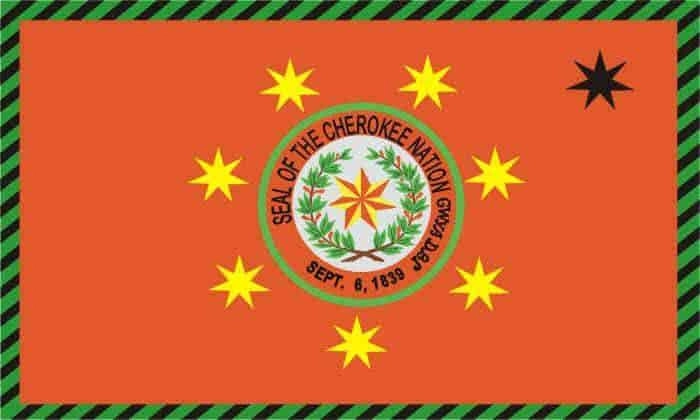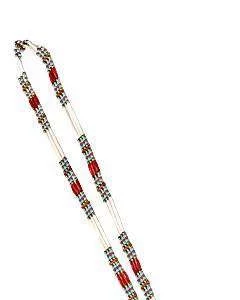The Cherokee Tribe of today is made of 3 different groups that all descend from the same common tribe.
The Cherokee Nation of Oklahoma
These citizens reside within 14 counties in Northeastern Oklahoma. The tribe is composed of descendants of those who were forced removed from lands in the Southeastern United States during the 1838-1839 Removal. In addition, it also comprises descendants of “Old Settlers” which were those who had moved from lands in the east before 1833 and are subject to the 1828 and 1833 treaties.
Over 70,000 Cherokee reside within a 7,000 square mile geographical area, which is not a reservation but rather a federally recognized sovereign nation covering most of northeast Oklahoma. Its jurisdictional service area encompasses eight entire counties along with portions of six other counties.
As one of only three such federally recognized Cherokee tribes, the Cherokee Nation has both the sovereign right and the responsibility to exercise control and development over tribal assets, including more than 66,000 acres of land and 96 miles of the Arkansas Riverbed.
Today citizenship is granted if a Lineal Descendant from the Final Roll of the 1907 Dawes Commission of the applicant can be proven through birth and death records. Minimum Blood Quantum is not used for citizenship.
The Eastern Band of Cherokee Indians
EBC is comprised of Descendants of those who resided at the time in North Carolina through a provision called the Reservation Act of 1819 or by evading the United States Army and remaining behind in a landless state. By law, Native Americans were neither citizens of the United States nor the state where they resided; therefore they could not hold property.
An adopted Cherokee named Will Thomas bought land with the Cherokee's money, held the deeds in his name, and allowed the fugitive Cherokees to live on and work the land. This ambiguous status continued until after the Civil War when the Cherokee question surfaced again. After several years of legal wrangling, the Cherokee formed a corporation. As a business, the Cherokee could hold the land, and the land in turn was to become known as the Qualla Boundary with the Cherokee in control.
Today they live in far western North Carolina in an area known as Qualla Boundary which is a Land Trust, not a reservation as the Tribe owns the land. Enrollment is granted to the applicant if they can prove a minimum Blood Quantum of 1/16th degree of Cherokee blood and Lineal Descendant of an Ancestor that is listed on the Baker Roll of 1924. The Tribe was never subject to the Allotment Act of 1889 and was able to fend off attempts to force compliance until the Howard Wheeler Act of 1936 abolished Allotment.
United Keetoowah Band of Cherokees
The Keetoowah reside in present-day Oklahoma in the same 14 counties that the Cherokee Nation of Oklahoma also resides. In 1808, a delegation of Cherokees from the Upper and Lower towns of the Cherokee Nation went to Washington D.C. to inform the President of the United States that not all Cherokee people wanted to pursue what was deemed a ‘civilized' life. The delegation requested the President divide the Upper Towns, whose people wanted to establish a Regular government, from the Lower Towns who wanted to continue living traditionally. On January 9, 1809, the President of the United States allowed the Lower Towns to send an exploring party to find suitable lands on the Arkansas and White Rivers for habitation.
Seven of the most trusted men explored locations both in what is now Western Arkansas and also Northeastern Oklahoma. The people of the Lower Towns desired to move across the Mississippi to this area, onto vacant lands within the United States so that they might continue the traditional Cherokee life.
In 1817, the United States ceded such lands to the “Kituwah” people (also known as Old Settlers, or Western Cherokee) in exchange for a portion of the Cherokee lands they had occupied and were entitled to in the East. As many as 4,000 Kituwah Old Settlers came. The Treaty of 1817 with the United States exchanged lands back East for lands in Arkansas. This gained the Keetoowahs (accepted spelling) a definite title to a territory of what is called today a “Land Base.”
Enrollment today is by tracing Lineal Descendants from the 1949 Final Roll of the Keetoowah Band of Cherokees or Dawes Roll of 1907 and a minimum Blood Quantum of 1/4 degree. Applications are approved every month by the Tribal council.
PowWows.com earns commission from Ancestry.com
References:
1)History and Culture of the Cherokee Nation of Ok http://www.cherokee.org/AboutTheNation/History/Facts/24449/Information.aspx
2) History and Culture of Eastern Band of Cherokee Indian http://nc-cherokee.com/historyculture/
3) History and Culture of the United Keetoowah Band of Cherokee http://www.keetoowahcherokee.org/documents/history/historyessay.pdf
Last Updated on January 5, 2024 by Paul G





danice bond
says:my grandmother when is Easter Bond sitting downfrom the Eastern band Cherokee she was an Indian princess I am her granddaughter from dhubert John on her son sitting downI would like to know more of my princess descendants and doesn’t that make me a princess I’m 52 years old going on I just found out I am a descendant of an Indian princess I would like to know more and maybe publish a book one day soon how was it twins my brother was Daniel Bond
Josiah Hair
says:I don’t understand folks that use the term “Indian Princess”.
Cherokees never had a royal family nor were the daughters of the Chief ever called Princess. After 1825 Cherokees elected the Principle Chief and certainly the daughters of the chief would never be called Princess or for that matter the son called Prince. This is a myth that has sprung up over time but is not based in reality.